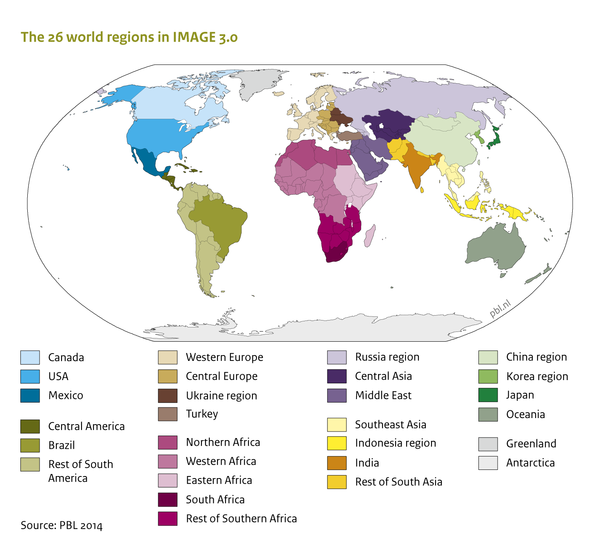IMAGE framework summary/Description
{{FrameworkSummaryPartTemplate |PageLabel=Model description |Sequence=2
|Description=
The IMAGE framework is structured according to the causal chain of key global sustainability issues (see Figure 2.1). IMAGE comprises two main systems. The Human or socio-economic system describes the long-term development of human activities relevant for sustainable development. The Earth system describes changes in the The IMAGE framework is structured according to the causal chain of key global sustainability issues (see below). IMAGE comprises two main systems. The Human or socio-economic system describes the long-term development of human activities relevant for sustainable development. The Earth system describes changes in the natural environment. The two systems are linked by the impacts of human activities on the Earth system, and by the impacts of environmental change in the Earth system on the Human system.
Key features of IMAGE
Spatial scale
The Human system and the Earth system in IMAGE 3.0 are specified according to their key dynamics. The geographical resolution for socio-economic processes is 26 regions selected because of their relevance for global environmental and/or development issues, and the relatively high degree of coherence within these regions (Figure below). In the Earth system, land use and land-use changes are presented on a grid of 5x5 minutes, while the processes for plant growth, carbon and water cycles are modelled on a 30x30 minutes resolution.
See Region classification for a detailed overview of the IMAGE 3.0 regions.
Temporal scale
The Human system and the Earth system each run at annual or five-year time steps focusing on long-term trends to capture inertia aspects of global environmental issues. In some IMAGE model components, shorter time steps are also used, for example, in water, crop and vegetation modelling, and in electricity supply. The model is run up to 2050 or 2100 depending on the issues under consideration. For instance, a longer time horizon is often used for climate change (see Section 1.6 ***). IMAGE also runs over the historical period 1971-2005 in order to test model dynamics against key historical trends.
Modular structure
IMAGE has been set-up as an integrated assessment framework in a modular structure, with some components linked directly to the model code of IMAGE, and others connected through soft links (the models run independently with data exchange via data files). This architecture provides more flexibility to develop components separately and to perform sensitivity analyses, recognising that feedback may not always be strong enough to warrant full integration. For example, the various components of the Earth system are fully linked on a daily or annual basis. However, components of the Human system, such as the TIMER energy model and the agro-economic model MAGNET, are linked via a soft link, and can also be run independently.
The IMAGE core model comprises most parts of the Human system and the Earth system, including the energy system, land-use and plant growth, carbon and water cycle model LPJmL. The IMAGE framework includes soft-linked models, such as the agro-economic model MAGNET, and PBL policy and impact models, such as FAIR (climate policy), GLOBIO (biodiversity), GLOFRIS (flood risks) and GISMO (human development). See Computer models overview.
The Rio+20 study
Using the IMAGE model, the PBL study Rio+20 (PBL, 2012) assessed pathways to achieve ambitious global sustainability targets in 2050, including limiting climate change to 2 °C, stabilising biodiversity loss and providing full access to energy, water and food. The baseline scenario assessed possible development without major changes in current policies. Three alternative scenarios assessed possible routes to achieving the sustainability targets. The first scenario (Global Technology) was directed to achieving the target mainly through large-scale introduction of advanced technologies. The second scenario (Decentralised Solutions) assessed achieving the long-term targets by introducing small-scale technologies and emphasising local-scale solutions. The third scenario (Consumption Change) focused on the role of lifestyle changes in achieving the targets. In this chapter, the Rio+20 study is used to illustrate potential assessments with IMAGE.
